Post-Gupta Period (600AD – 750AD)- 1 | Additional Study Material for UPSC PDF Download
Area of interest : North India, Deccan India & South India


Political situation became complex with the passing away of the Guptas and the demise of the Vakataka rulers. Vassals of the Guptas became independent in the North.
In the Deccan and far South too multiplicity of powers was witnessed.
≫ NORTH INDIA
(i) Political Background
Harshavardhana (590 AD to 648 AD) –
The fall of the Gupta rulers paved the way for domination of the Later Guptas, Maukharis and Pushyabhutis in the North. Harsha, though a Pushyabhuti ruler of Thaneswar ruled from Kanauj, which was originally the seat of Maukharis, with whom he contracted a marriage alliance. Harsha is celebrated as last ‘Hindu’ ruler in the North post the Gupta era.
(ii) Literature and Language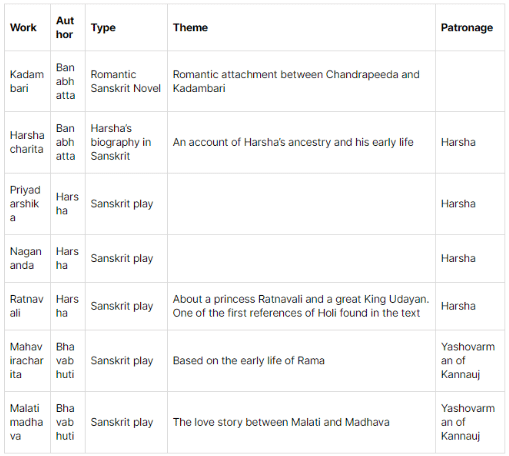
(iii) Religion
All religions were patronized under Harshavardhana’s reign. He was a Shaivite, but later Hiuen Tsang converted him to Mahayana Buddhism.
Hiuen Tsang who visited Harshavardhana’s empire noted Buddhism was declining in India while Brahmanism was on rise.
(iv) Art and Architecture
The art and architectural contributions of Harsha’s period are very few and mostly followed the Guptas. Harshavardhana’s realm is associated with construction of numerous stupas and monasteries. Harsha patronised the Nalanda University by his liberal endowments.
The brick temple of Lakshmana at Sirpur with its rich architecture is assigned to the period of Harsha.
Lakshamana temple, Sirpur
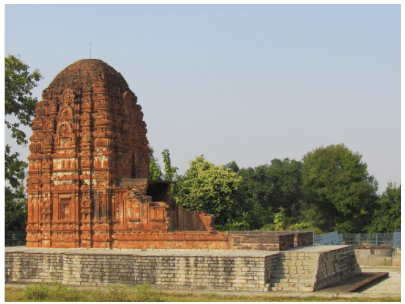
- The Lakshamana temple is located in the village Sirpur of Chattisgarh.
- It is dedicated to Lord Vishnu
DECCAN INDIA
I. Political Background
The late sixth century is marked by rise of Badami Chalukyas around the North Eastern part of Karnataka. The empire was founded by Pulakesin I. Pulakesin II (610 – 642 AD ) is considered the greatest ruler of the house.
II. Literature and Language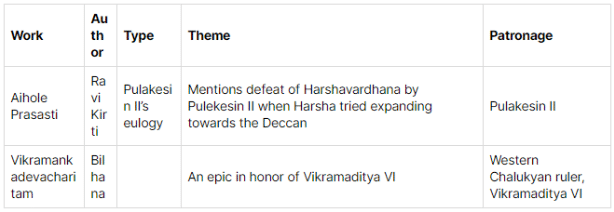
III. Religion
Chalukyans were both Vaishanavas and Shaivites but had a greater inclination towards Vaishnavism and Jainism. Nonetheless, they patronized all religions.
IV. Architecture
(A) Caves
Cave temple architecture was also famous under the Chalukyas. Their cave temples are found in Ajanta, Ellora and Nasik.
(B) Temples
Chalukyan temples are found in 3 places – Badami, Aihole and Pattadakal.
Badami – Badami cave temples are a complex of 6 temples – 4 Hindu, 1 Jain & 1 possibly Buddhist.

Cave 3 – Vishnu image
Aihole – Ladkhan temple, Durga temple and Ravana Phadi Temple
Durga temple
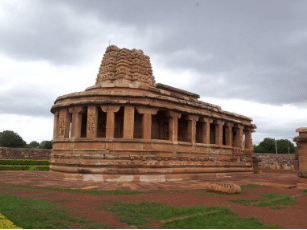
- It is an apsidal temple of 550 AD. The apsidal shape is similar to the shape of a Buddhist chaitya.
- Temple has an open pillared verandah serving as pradakshinapatha instead of a dark ambulatory path.
- Temple shows improvements in shikhara development as compared to the Gupta period.
Ravana Phadi Temple
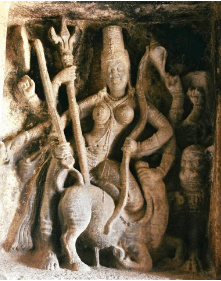
- Ravana Phadi is a rock cut cave with distinct sculptures made during the Chalukyan era.
- Among numerous sculptures is the Goddess Durga is portrayed in the carving. She appears to be slaying Mahishasura (panel above).
Pattadakal – This temple complex has 10 temples – 4 Dravida style, 4 in Nagara style, 1 Vesara style & 1 Jain Sanctuary. The Papanath temple is the Nagara style temple.
Virupaksha Temple
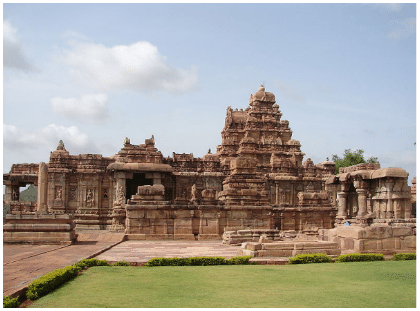
- Largest and grandest temple in Pattadakal
- Built in 8th Century by Queen Lokamahadevi to commemorate her husband’s (Vikramaditya II’s ) victory over Pallava ruler.
≫ SOUTH INDIA
(i) Political Background
The Pallavas were feudatories of the Satavahanas. After the fall of the Satavahanas in third century AD, they became independent. They ruled in the Tondaimandalam area with Kachipuram as their capital. The 7th Century marked the rise of great rulers like Mahendravarman, Narasimhavarman I and Rajasimha. The Pallava rule reached its zenith under these rulers.
(ii) Literature and Language

(iii) Religion
The Tamil society witnessed a great change during the Pallava period.
(1) Hinduism
The Brahmins occupied a high place in the society. Brahmanism and Brahmins were patronized by the rulers. The Pallava period witnessed the rise of Saivism and Vaishnavism.
- Bhakti Cult
The Saiva Nayanmars and the Vaishnava Alwars contributed to the growth of Saivism and Vaishnavism. Apar and Sambandar were Shaivite bhakti saints who contributed immensely to the growth of Shaivism.
(2) Buddhism and Jainism
Increased patronage to Hinduism and revival by Bhakti movement led to decline of Buddhism and Jainism.
(iv) Architecture
(1) Temples
This era is significant for temple building activities as the Dravidian style of temple architecture began. The Pallavas introduced the art of excavating temples out of rocks. We see a gradual evolution starting from the cave temples to monolithic rathas which culminated in structural temples. The development of temple architecture under the Pallavas can be seen in 4 stages.
(a) Stage I – Mahendra phase
This stage sees the development of Pallava rock-cut temples under Mahendravarman I. They were built in many places. The most important among them are Pallavaram, Mamandur, Mahendravadi, Vallam and Thalavanur.
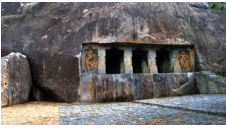
Pallavaram Caves
(b) Stage II – Mamallapuram phase
The second stage of Pallava architecture is represented by the monolithic rathas and mandapas found at Mamallapuram (Mahabalipuram). The name ‘Mammalapuram’ is derived from Narshimahavarman’s name ‘Mamalla’ which means the ‘great wrestler’.
There are 5 Rathas – Dharmaraj Ratha, Bhim Ratha, Arjuna Ratha, Draupadi Ratha, Nakul Sahdev. These rathas, popularly called as the Panchapanadava rathas, signify 5 different styles of temple architecture. Dharmaraja Rath is the largest and it’s considered a precursor for the Dravidian style.
• Rathas of Mahabalipuram
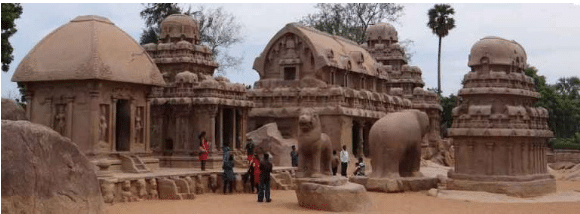
- The South saw the emergence of Dravida style of architecture. Earliest Dravida style is visible at Mahabalipuram where during the Pallava period were constructed different rock cut structures called rathas.
- Main shrine has a square ground plan
- The superstructure above the shrine instead of having a shikhara, has horizontal platforms each placed one above the other with the size receding upwards. This is called a vimana.
- Constructed under the patronage of Mahendravarman I and Narsimhavarman I.
The mandapas contain beautiful sculptures on its walls. The most popular of these mandapas are Varaha Madapam, Mahishasuramardhini Mandapa, Tirumurthi Mandapam and the Panchpandava Caves.
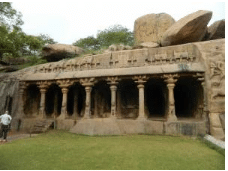
Panchpandava Caves
(c) Stage III – Rajasimha phase
This stage witnesses the evolution of structural temples in South India. These temples were built by using the soft sand rocks. The Kailasanatha temple at Kanchi and the Shore temple at Mamallapuram remain the finest examples of the early structural temples of the Pallavas.
• Shore Temple
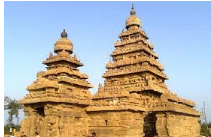
- The Shore temple is located in Mamallapuram.
- Its name is credited to its presence at the shore of Bay of Bengal.
- Built by Rajasimha.
- Made up of granite
- A Shaiva temple but also has a Vaishnava shrine
• Kailasanatha Temple
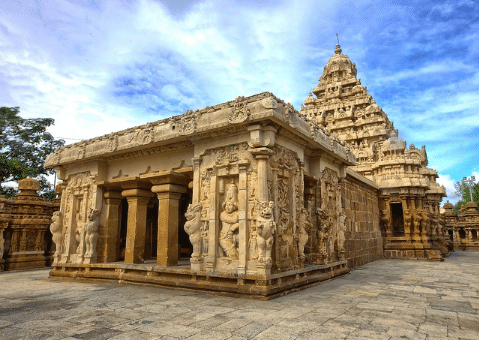
- This temple is the oldest structure in Kanchipuram.
- Located in Tamil Nadu, it is a Hindu temple dedicated to Lord Shiva.
- Dravidian style temple.
- Built by Rajasimha.
(d) Stage IV – Nandivarman phase
The last stage of the Pallava art is also represented by structural temples built by the later Pallavas. The Vaikundaperumal temple and Muktheeswara temple at Kanchipuram belong to this stage of architecture.
• Vaikunda Perumal Temple

- Dedicated to Lord Vishnu
- Dravidian style
(e) Art
The Pallavas had also contributed to the development of sculpture. Apart from the sculptures found in temples, an ‘Open Art Gallery’ at Mamallpuram remains an important monument.
The Descent of the Ganga or Arjun’s penance remains the most important sculpture.
• Descent of Ganga/ Arjun’s penance
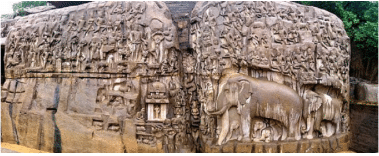
- Made of a monolithic rock
- Found in Mahabalipuram, Tamil Nadu
- Identified as Bhagiratha’s bringing Ganga down from the matted locks of Shiva
- It is also identified as Arjun’s penance
- Declared a UNESCO World Heritage Site.
The Sittannavasal jain paintings belonged to the period of Pallavas.
|
21 videos|562 docs|160 tests
|
FAQs on Post-Gupta Period (600AD – 750AD)- 1 - Additional Study Material for UPSC
| 1. What is the significance of the Post-Gupta Period in Indian history? |  |
| 2. Which famous dynasty emerged during the Post-Gupta Period? |  |
| 3. What were the major religious developments during the Post-Gupta Period? |  |
| 4. How did the Post-Gupta Period contribute to the development of art and architecture? |  |
| 5. What were the major political changes during the Post-Gupta Period? |  |
















